
A comic book, also called comicbook, comic magazine or simply comic, is a publication that consists of comics art in the form of sequential juxtaposed panels that represent individual scenes. Panels are often accompanied by descriptive prose and written narrative, usually, dialogue contained in word balloons emblematic of the comics art form.

The Silver Age of Comic Books was a period of artistic advancement and widespread commercial success in mainstream American comic books, predominantly those featuring the superhero archetype. Following the Golden Age of Comic Books and an interregnum in the early to mid-1950s, the Silver Age is considered to cover the period from 1956 to 1970, and was succeeded by the Bronze Age.
Entertaining Comics, more commonly known as EC Comics, was an American publisher of comic books, which specialized in horror fiction, crime fiction, satire, military fiction, dark fantasy, and science fiction from the 1940s through the mid-1950s, notably the Tales from the Crypt series. Initially, EC was owned by Maxwell Gaines and specialized in educational and child-oriented stories. After Max Gaines' death in a boating accident in 1947, his son William Gaines took over the company and began to print more mature stories, delving into the genres of horror, war, fantasy, science-fiction, adventure, and others. Noted for their high quality and shock endings, these stories were also unique in their socially conscious, progressive themes that anticipated the Civil Rights Movement and the dawn of the 1960s counterculture. In 1954–55, censorship pressures prompted it to concentrate on the humor magazine Mad, leading to the company's greatest and most enduring success. Consequently, by 1956, the company ceased publishing all of its comic lines except Mad.
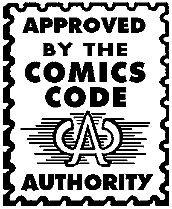
The Comics Code Authority (CCA) was formed in 1954 by the Comics Magazine Association of America as an alternative to government regulation. The CCA enabled comic publishers to self-regulate the content of comic books in the United States. The code was voluntary, as there was no law requiring its use, although some advertisers and retailers looked to it for reassurance. Some publishers, including Dell, Western, and Classics Illustrated, never used it. Its code, commonly called "the Comics Code", lasted until the early 21st century. The CC formation followed a moral panic centered around a series of Senate hearings and the publication of psychiatrist Fredric Wertham's book Seduction of the Innocent.
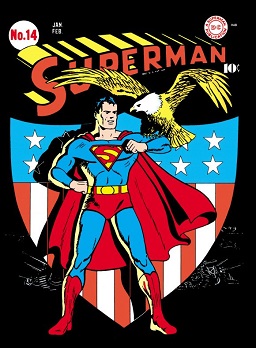
The Golden Age of Comic Books describes an era of American comic books from 1938 to 1956. During this time, modern comic books were first published and rapidly increased in popularity. The superhero archetype was created and many well-known characters were introduced, including Superman, Batman, Robin, Captain Marvel, Captain America, and Wonder Woman.

Fredric Wertham was a German-American psychiatrist and author. Wertham had an early reputation as a progressive psychiatrist who treated poor black patients at his Lafargue Clinic at a time of heightened discrimination in urban mental health practice. Wertham also authored a definitive textbook on the brain, and his institutional stressor findings were cited when courts overturned multiple segregation statutes, most notably in Brown v. Board of Education.

An American comic book is a thin periodical originating in the United States, on average 32 pages, containing comics. While the form originated in 1933, American comic books first gained popularity after the 1938 publication of Action Comics, which included the debut of the superhero Superman. This was followed by a superhero boom that lasted until the end of World War II. After the war, while superheroes were marginalized, the comic book industry rapidly expanded and genres such as horror, crime, science fiction and romance became popular. The 1950s saw a gradual decline, due to a shift away from print media in the wake of television and the impact of the Comics Code Authority. The late 1950s and the 1960s saw a superhero revival and superheroes remained the dominant character archetype throughout the late 20th century into the 21st century.

Seduction of the Innocent is a book by German-born American psychiatrist Fredric Wertham, published in 1954, that warned that comic books were a negative form of popular literature and a serious cause of juvenile delinquency. The book was taken seriously at the time in the United States, and was a minor bestseller that created alarm in American parents and galvanized them to campaign for censorship. At the same time, a U.S. Congressional inquiry was launched into the comic book industry. Subsequent to the publication of Seduction of the Innocent, the Comics Code Authority was voluntarily established by publishers to self-censor their titles. In the decades since the book's publication, Wertham's research has been disputed by scholars.
Mainline Publications, also called Mainline Comics, was a short-lived, 1950s American comic book publisher established and owned by Jack Kirby and Joe Simon.
The United States Senate Subcommittee on Juvenile Delinquency was established by the United States Senate in 1953 to investigate the problem of juvenile delinquency.
The Association of Comics Magazine Publishers (ACMP) was an American industry trade group formed in the late 1940s to regulate the content of comic books in the face of public criticism during that time. It was a precursor to the Comics Magazine Association of America, and the ACMP Publishers Code served as the template for a more detailed set of rules enforced by the CMAA's Comics Code Authority.

Superhero fiction is a genre of speculative fiction examining the adventures, personalities and ethics of costumed crime fighters known as superheroes, who often possess superhuman powers and battle similarly powered criminals known as supervillains. The genre primarily falls between hard fantasy and soft science fiction in the spectrum of scientific realism. It is most commonly associated with American comic books, though it has expanded into other media through adaptations and original works.
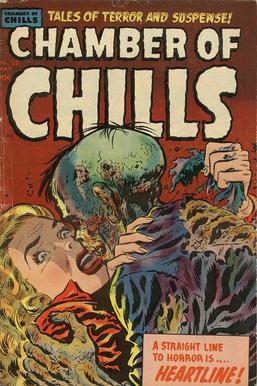
Chamber of Chills is the name of two anthology horror comic books, one published by Harvey Publications in the early 1950s, the other by Marvel Comics in the 1970s.

Stan Lee was an American comic book writer, editor, publisher, and producer. He rose through the ranks of a family-run business called Timely Comics which would later become Marvel Comics. He was the primary creative leader for two decades, leading its expansion from a small division of a publishing house to a multimedia corporation that dominated the comics and film industries.

The Brooklyn Thrill Killers were a gang of teenage boys who, during the summer of 1954, killed two men and committed acts of assault and torture against several other people in Brooklyn, a borough of New York City. The case attracted considerable media attention in the United States. It also fueled the controversy over comic books, which were accused at the time of causing sexual perversion and juvenile delinquency.
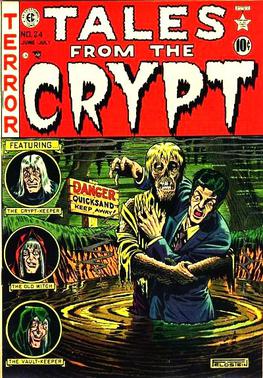
Horror comics are comic books, graphic novels, black-and-white comics magazines, and manga focusing on horror fiction. In the US market, horror comic books reached a peak in the late 1940s through the mid-1950s, when concern over content and the imposition of the self-censorship Comics Code Authority contributed to the demise of many titles and the toning down of others. Black-and-white horror-comics magazines, which did not fall under the Code, flourished from the mid-1960s through the early 1980s from a variety of publishers. Mainstream American color comic books experienced a horror resurgence in the 1970s, following a loosening of the Code. While the genre has had greater and lesser periods of popularity, it occupies a firm niche in comics as of the 2010s.

Superhero comics are one of the most common genres of American comic books. The genre rose to prominence in the 1930s and became extremely popular in the 1940s and has remained the dominant form of comic book in North America since the 1960s. Superhero comics feature stories about superheroes and the universes these characters inhabit.
Harold "Hal" Ellson was an American author of pulp fiction whose work primarily focused on juvenile delinquency, a field in which he has been described as "one of the most popular" writers and as "legendary".
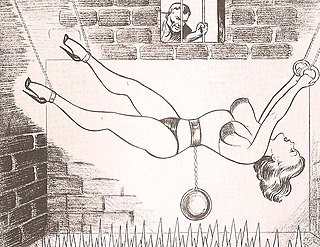
Nights of Horror is an American series of fetish comic books, created in 1954 by publisher Malcla, drawn by comic artist Joe Shuster, who is also one of the original creators of Superman. The comic stories were written by an author under the pseudonym Clancy, who also used other pseudonyms for different issues of the books. The stories are based on situations of BDSM, bondage, torture, and sexual slavery, featuring both men and women as the tormentors and victims. The series was important in the conviction of Jack Koslow in 1954, during the trial of the Brooklyn Thrill Killers. The books themselves were seized and banned first by New York City, then by the State of New York for violating obscenity laws, and the case went to the Supreme Court of the United States. The Court determined that the ban was not in violation of First Amendment rights, and upheld New York's request for destroying copies of Nights of Horror. Shuster was never named as the illustrator until Gerard Jones published the information in 2004.

The Lafargue Mental Health Clinic, more commonly known as the Lafargue Clinic, was a mental health clinic that operated in Harlem, Manhattan, New York, from 1946 until 1958. The clinic was named for French Marxist physician Paul Lafargue and conceived by German-American psychiatrist Fredric Wertham, who recognized the dire state of mental health services for blacks in New York. With the backing of black intellectuals Richard Wright and Ralph Ellison, as well as members of the church and community, the clinic operated out of the parish house basement of St. Philip's Episcopal Church and was among the first to provide low-cost psychiatric health services to the poor, especially for poor blacks who either could not afford treatment at New York hospitals or faced racial discrimination from doctors and other hospital staff. The staff consisted entirely of volunteers, and Wertham and Hilde Mosse were the clinic's lead doctors.












